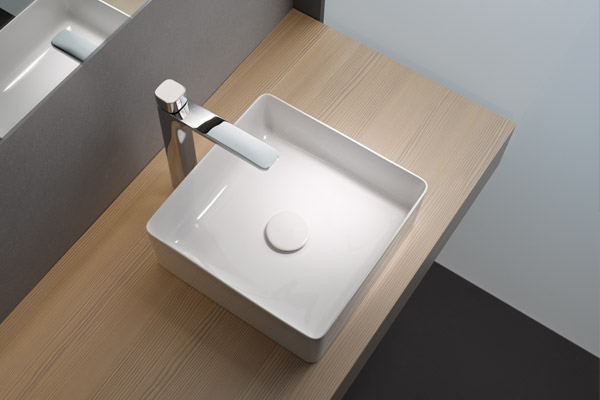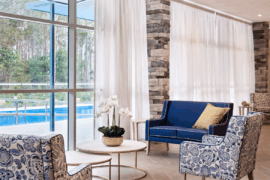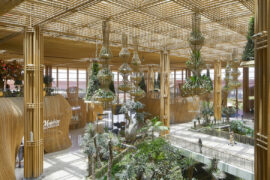A Luis Barragan-inspired pavilion by Hermès at La Pelota housed objects of absolute precision under striking light and shadow during Milan Design Week.
To understand the objects and furniture for the home by Hermès – and they are indeed objects to be understood (the result of an intellectual as much as a passionate and creative approach) – is to understand the heritage of Hermès.
The brand’s equestrian roots (in saddle and harness making in the 1830s) continue to permeate through its design for the home, which is lead by Deputy Artistic Directors Charlotte Macaux Perelman and Alexis Fabry under Artistic Director Pierre-Alexis Dumas.
The focus of many of the objects is leather as a form of linkage – dressing objects as it dressed the horse in the form of saddles and harnesses. More accurately, the leather is used as a means of ‘revealing’ the objects just as it formerly ‘exposed’ the body of the horse (which was previously concealed and hampered by ceremonial trappings). As lids, straps and sheathing, leather serves as a link between materials such as maple, lacquer, wicker, crystal and metal, as well as between the object and the user of the object.
The Collections for the Home 2017-2018 consist of multiple families of objects, and it is in the Lien d’Hermès collection that the focus on leather as a link is most apparent. Designed by Studio Hermès in collaboration with Guillaume Delvigne and Damian O’Sullivan, in this collection bridle leather sculpts and draws forms such as hangers a log basket, and outlines shapes such as vases and boxes. In the Équipages d’Hermès and Object of Art de Vivre collections (designed by Studio Hermès), leather sumptuously lines surfaces on a serving trolley, occasional table, writing desk and small boxes.
Other newly released objects include a trio of bamboo seats with removable leather cushions titled Karumi – designed by Alvaro Siza and shaped into extremely precise and sinuous forms by a Japanese master craftsman with a fusion of carbon fibre. Barber Osgerby also contributed with a monumental cast bronze coffee table titled Aes. Plaids, furnishing fabrics, wallpapers and a porcelain dinner set completed the presentation of objects.
“Our main highlights are precision, balance, the match between the various materials,” Alexis Fabry told us at the Hermès pavilion at La Pelota. Charlotte Macaux Perelman added, “There is a very strong link between the architecture we’ve chosen, the objects and the scene. We really wanted to strike a balance between the three things.” Similarly, the objects themselves are presented in a balanced manner with a non-hierarchical sequence. “Everything is on the same footing, be it textile, wallpaper, home object, tableware or furnishing,” said Fabry.
Macaux Perelman designed the pavilion of whitewashed brick walls, vivid red paving bricks (handmade in Italy) and over-sized timber beams that cast intense diagonal shadows over a brightly lit sequence of rooms. “We wanted a very light place with a Mediterranean atmosphere. We really wanted to create a tension – a sort of vibration – and convey the impression of light and the impression of not being in a pavilion but being in a building,” explained Macaux Perelman.
From the form and detail of each object to the form and atmosphere of the pavilion, the presentation conveyed absolute precision. One would expect nothing less of Hermès.
INDESIGN is on instagram
Follow @indesignlive
A searchable and comprehensive guide for specifying leading products and their suppliers
Keep up to date with the latest and greatest from our industry BFF's!

A longstanding partnership turns a historic city into a hub for emerging talent

London-based design duo Raw Edges have joined forces with Established & Sons and Tongue & Groove to introduce Wall to Wall – a hand-stained, “living collection” that transforms parquet flooring into a canvas of colour, pattern, and possibility.

Reece unveils the revolutionary SaphirKeramik material, opening the way for new and innovative bathware design.

With a focus on selective usage and natural regeneration, hardwood forests in the US are being managed sustainably. See how this combines with the knowledge of designers to make timber a sustainable and sophisticated choice.
The internet never sleeps! Here's the stuff you might have missed

With the 2025 INDE.Awards now over, it’s time to take a breath before it all begins again in early December. However, integral to the awards this year and every year is the jury – and what an amazing group came together in 2025.

Inspired by an unthinkable design challenge on Sydney Harbour, Materialised’s ingenuity didn’t just fuse acoustic performance with transparent finesse – it forever reimagined commercial curtain textiles by making the impossible possible.

Winner of the INDE.Awards 2025 Best of the Best, Terminal 2 Kempegowda International Airport Interiors by Enter Projects Asia and SOM showcases 12,000-square-metres of biophilic design, featuring nine kilometres of handwoven rattan in a sustainable, world-class passenger experience.